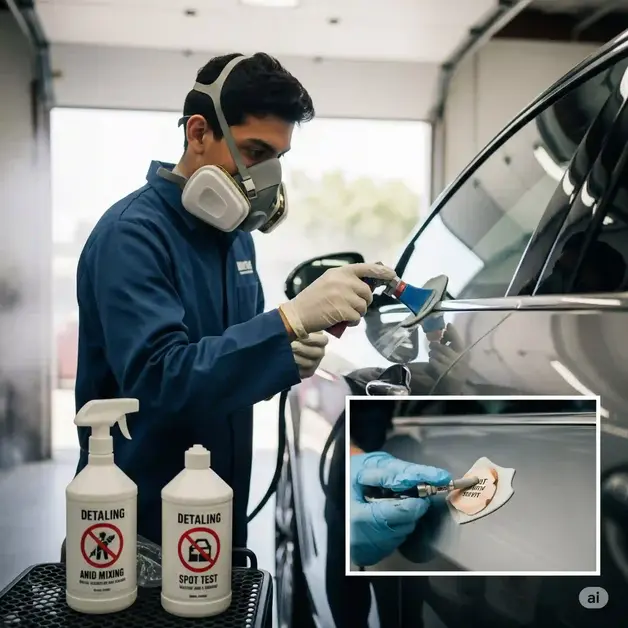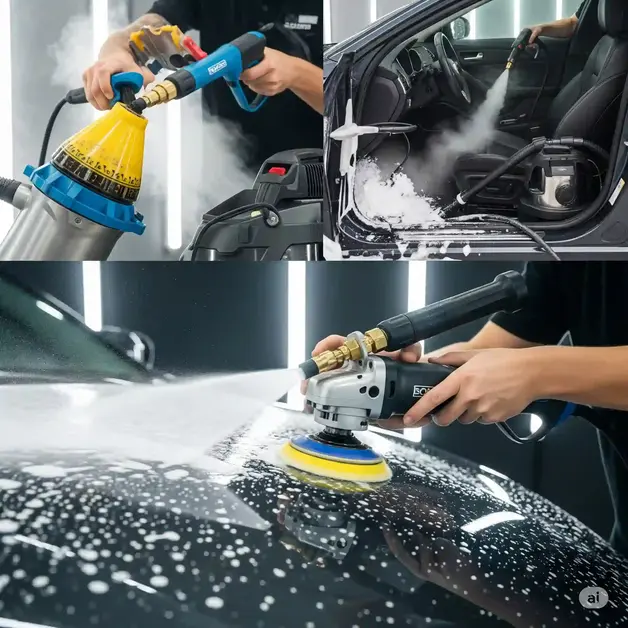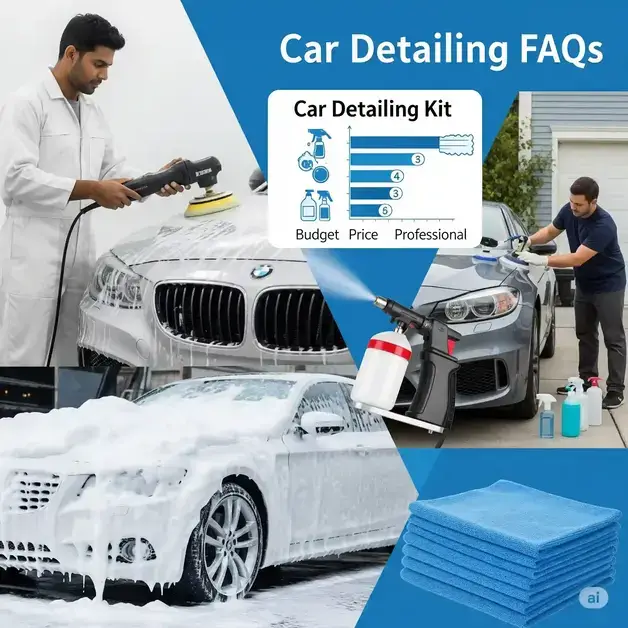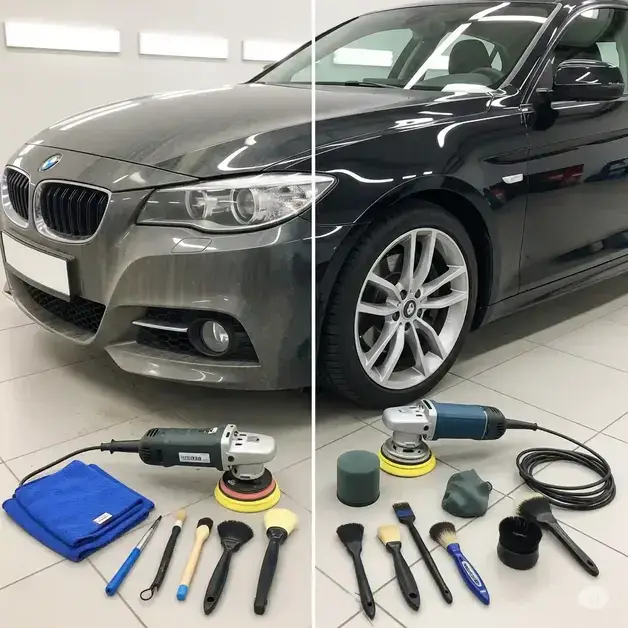I used to think a quick car wash at the gas station was enough. But then I saw swirl marks, dull trim, and dirt in spots I had missed. That’s when I found out how much good car detailing tools can help. With the right gear, your car can shine like new. I’ve tried cheap tools and pro ones too. In this guide, I’ll show you the best car detailing tools that made a real difference for me. If you want a clean, sharp look, these detailed tools for cars will get you there.
What Are Car Detailing Tools and Why Do They Matter?
So, what exactly are car detailing tools? Think of them as your car’s personal grooming kit—like clippers, brushes, and skincare products, but for paint, wheels, and interiors. These tools go beyond the usual soap and sponge. They’re made to clean, protect, and restore every inch of your vehicle, inside and out.
Short answer: Car detailing tools are specialized items designed to clean, restore, and protect your vehicle in ways a basic car wash can’t.
Now, here’s the thing most people miss (I did too): there’s a huge difference between just washing your car and detailing it. Washing is like a quick rinse. Detailing? That’s like giving your car a spa day. When I first tried detailing tools instead of using a random towel and dish soap, I was blown away. My faded hood looked glossy again. My dull rims started to reflect sunlight like chrome.
Short answer: Detailing goes deeper than washing—it removes hidden grime, restores surfaces, and brings out your car’s true shine.
I remember the day I realized this. I had just picked up a new microfiber mitt and a proper car shampoo (not that harsh stuff under the kitchen sink). I followed the two-bucket method, dried it off with a plush microfiber towel, and stepped back. It looked like I’d taken it to a professional shop. But I hadn’t—I did it in my driveway. That moment? It changed how I care for my car.
Short answer: The right car detailing tools helped me transform my car from average to eye-catching—right at home.
If you’ve ever wondered why your car never quite sparkles like the ones at shows or in ads, the answer is probably the tools you’re using. You can’t get a flawless finish with a kitchen rag and dish soap—trust me, I tried. The good news? You don’t need to be a pro to get pro-level results. You just need the right tools and a bit of practice.
Short answer: Using proper car detailing tools gives you professional results—without the pro-level price tag.
So whether you’re just getting started or already obsessed with clean cars (like me), this guide will walk you through the exact tools that made the biggest difference for me—and why they matter more than you might think.
Must-Have Basic Car Detailing Tools for Beginners
When I first got into detailing, I thought I needed every fancy gadget under the sun. Truth is, you only need a few solid car detailing tools to get started. These basics made the biggest difference for me—especially when I swapped out old habits for the right gear.
Short answer: A solid beginner car detailing kit should include microfiber towels, grit-guard buckets, pH-neutral shampoo, and soft brushes.
Let’s walk through the exact tools I wish I had from day one.
Microfiber Towels & Mitts
If you’re still using an old T-shirt or kitchen rag to dry your car—stop. I used to do that too, until I noticed faint swirl marks all over my hood. Microfiber changed everything. It’s soft, absorbent, and gentle on paint.
Short answer: Microfiber towels are a must-have because they prevent scratches and soak up water without leaving streaks.
I now keep different towels for different tasks—drying, buffing, glass, interior—you name it. Oh, and invest in a microfiber mitt for washing. It traps dirt better than a sponge and feels like a cloud in your hand.
Buckets with Grit Guards
This one’s simple but powerful: use two buckets. One for soapy water, one for rinsing your mitt. It keeps dirt from going back on your car. Add grit guards to the bottom of each bucket—they catch all the grime that could scratch your paint.
Short answer: Buckets with grit guards help prevent swirl marks by keeping dirty water away from your mitt.
The first time I tried the two-bucket method, my car looked cleaner, glossier, and I didn’t find any random scratches the next day. It’s a small change, but it made a huge difference.
pH-Neutral Car Shampoo
Not all soaps are created equal. I used dish soap once (yeah, big mistake). It stripped off my wax and left the paint feeling dry. A good pH-neutral car shampoo is gentle yet effective. It cleans without harming your car’s protective layers.
Short answer: pH-neutral car shampoo cleans safely without damaging wax or paint protection.
I’ve tested a few, and honestly, some smell amazing too—which makes the whole wash feel kind of therapeutic. Look for shampoos that foam well and rinse clean without residue.
Soft Detailing Brushes
You’d be shocked at how much dust hides in your air vents, cup holders, and around emblems. A good set of soft detailing brushes is perfect for those tricky areas. I use smaller ones for interiors and slightly stiffer ones for badges and grills.
Short answer: Soft detailing brushes help clean tight spots without scratching delicate surfaces.
I once used an old toothbrush on my dashboard—never again. It left tiny marks I couldn’t unsee. Since then, my soft-bristle brush has been a favorite. It’s like a little magic wand for dust.
These four tools—microfiber towels, buckets with grit guards, pH-neutral shampoo, and detailing brushes—are my must-haves. They’re the foundation of any good car detailing kit and a smart investment if you care about keeping your car looking fresh.
You don’t need to spend a fortune either. I built my first setup for under $50, and the results were better than I ever got from those quick gas station washes.
Short answer: With just a few basic tools, you can achieve pro-level results at home—no experience required.
Advanced Car Detailing Tools That Changed My Game
Once I got the hang of the basics, I wanted more. I wasn’t just washing my car anymore—I was detailing it. That’s when I started investing in a few advanced car detailing tools, and let me tell you—they completely changed the game for me.
Short answer: Advanced car detailing tools help you restore, protect, and deep-clean your vehicle with professional-level results at home.
These aren’t gimmicks. Each one earned its spot in my garage because it made the process faster, better, or just more satisfying.
Dual-Action Polisher
This was the tool that made me feel like a real detailer. A dual-action (DA) polisher is way safer than a rotary buffer. It spins and oscillates at the same time, so it’s much harder to burn your paint or leave holograms.
Short answer: A dual-action polisher lets you safely remove swirls, oxidation, and scratches—even if you’re a beginner.
The first time I used mine, I tackled the faded clear coat on my hood. It had been dull for years. A few passes with some cutting polish, and it came back to life. I couldn’t believe I did that myself—and without paying a pro hundreds.
Foam Cannon
If you’ve never used a foam cannon, prepare to become addicted. You hook it up to a pressure washer, and it shoots thick snow-like foam all over your car. It’s fast, fun, and incredibly effective at loosening dirt before you touch the paint.
Short answer: A foam cannon covers your car in thick suds, reducing swirl marks and making washing way more fun.
My neighbors always peek over the fence when I use it. It’s oddly satisfying to watch the foam cling and drip off. More importantly, it helps me wash safer and quicker.
Steam Cleaner
Steam changed how I clean interiors—especially fabric, leather, and tight corners. A good steam cleaner blasts away grime, lifts stains, and kills bacteria, all without harsh chemicals.
Short answer: Steam cleaners deep-clean your interior while sanitizing surfaces—perfect for allergy sufferers or families.
I use mine for everything from floor mats to vents to steering wheels. It even got sticky gunk out of a cup holder I couldn’t reach with any brush. Plus, it leaves no chemical smell behind.
Vacuum + Blower Combo
This one was a game-changer for dealing with pet hair. My regular vacuum couldn’t cut it—especially on carpet or between the seats. A strong detailing vacuum with a blower option lets me clean and dry fast.
Short answer: A vacuum and blower combo helps you clean tough spots and dry crevices without water spots or leftover debris.
The blower part? Amazing for getting water out of mirrors, badges, and seams after washing. No more annoying drips showing up after you’ve already dried the car.
These might not be must-haves for beginners, but once you’ve got the basics down, they’re worth every penny. Each of these best car detailing tools helped me get closer to that “showroom” finish without stepping foot in a professional shop.
Short answer: Upgrading to advanced detailing tools brings out the full potential of your car’s finish—and makes detailing more enjoyable.
You don’t need all of them at once. I added mine one at a time as I learned and wanted more control. Start with what fits your needs and budget—and upgrade as you go.
Optional (But Helpful) Accessories to Upgrade Your Kit
Once I got comfortable with the basics, I started adding a few extras to my car detailing kit. And honestly? They made a big difference. These tools aren’t required for beginners, but they do help if you want faster, better results with less effort.
Short answer: Optional car detailing tools help you clean deeper, spot hidden dirt, and prep your paint for wax or polish.
Here are the extras I use most often—and why I swear by them.
Detailing Clay Bar
After a full wash, my car looked clean—but still felt rough when I ran my hand over the paint. That’s when I found out about clay bars. They pull off stuff like sap, brake dust, or road film that soap leaves behind.
Short answer: A clay bar removes stuck-on dirt and smooths your paint before waxing.
Now I use it every few months, right before waxing or sealing. It makes the paint feel smooth like glass. It’s kind of like exfoliating your skin before using lotion—it just makes everything work better.
LED Detailing Light
Have you ever finished drying your car in the shade, then spotted streaks in the sunlight? Same here. That’s why I picked up an LED detailing light. It shows swirl marks, dust, and smudges your eyes would miss—especially indoors or at night.
Short answer: An LED detailing light helps you see flaws and spots you might miss in low light.
At first, I thought it was too much. But once I used it after polishing, I was hooked. I could see tiny marks I had missed. Now I use it all the time when I want that perfect, mirror-like shine.
Plastic Razor Blades
I know—“razor” sounds risky around paint. But these are plastic blades, and they’re safe. I use them to remove stickers, sap, bugs, and old decals without scratching glass or clear coats.
Short answer: Plastic razor blades let you scrape off sticky stuff without harming your car’s surfaces.
I used mine to take off a faded parking sticker from my windshield. It came off clean with no scratches. Just use gentle pressure and keep the blade flat, and you’re good to go.
These tools aren’t essential at first, but they quickly become favorites. Each one helped me get better results with less work—and they made the process more fun too.
Short answer: These extras aren’t must-haves, but they’ll boost your results and make detailing easier.
Try adding one or two at a time. You don’t need everything all at once. But trust me—once you try a clay bar or catch a swirl under the LED light, you’ll wonder how you did without them.
My Favorite Cleaning Solutions & Conditioners
Let’s be real—no matter how fancy your car detailing tools are, if your cleaning products are junk, your results will be too. I learned this the hard way with streaky glass cleaners and greasy leather sprays. Once I found products that actually worked, my detail days got faster and the finish looked way better.
Short answer: The right cleaning solutions and conditioners protect your car and make the results last longer.
Here are the ones I keep stocked and actually use every time.
Wheel Cleaners That Actually Work
I used to scrub forever with regular soap and still end up with brake dust stains. Then I switched to an iron-removing wheel cleaner—and boom, the wheels looked brand new with way less effort.
Short answer: Use a pH-balanced wheel cleaner that targets brake dust without damaging your rims.
I like ones that turn purple as they react with iron (so satisfying to watch). Meguiar’s and Griot’s Garage both make solid options that work on chrome, alloy, and painted wheels. Just spray, wait, and rinse—no crazy scrubbing needed.
Leather Conditioners That Don’t Leave Grease
Leather seats are tricky. I want them clean and soft—not shiny or slippery. Some cheap sprays left them feeling oily and sticky. But a good conditioner keeps the leather hydrated and smooth without that fake showroom glow.
Short answer: A high-quality leather conditioner keeps seats soft, prevents cracks, and doesn’t feel greasy.
I’ve had great luck with Lexol and Chemical Guys Leather Conditioner. They go on smooth, soak in fast, and leave a clean matte finish. I use it once a month and my seats still look and feel fresh after years.
Streak-Free Glass Cleaners
Glass was always my weak spot. I’d clean my windshield, then catch streaks in the sunlight—super annoying. Then I found a foam-style glass cleaner that changed everything. It clings to the glass and wipes off clean.
Short answer: A foam or alcohol-based glass cleaner leaves windows crystal clear without streaks or haze.
I personally use Invisible Glass or Stoner’s Reach & Clean combo (the one with the extendable handle). It’s great for getting into tight corners like the bottom of the windshield. Just spray, wipe with a clean microfiber, and done.
I’m not loyal to brands just for the label—I stick with what works. These are the cleaners and conditioners that I trust because they make my job easier and my car look incredible.
Short answer: Choose cleaning products that save time, give better results, and protect your car’s surfaces for the long haul.
You don’t need to grab them all at once. Start with one or two upgrades and build your go-to list as you go. That’s how I did it—and now detailing feels less like a chore and more like therapy.
Interior vs Exterior: Toolkits You’ll Need for Each
I used to keep all my car detailing tools in one bin. I thought I could just grab whatever I needed and get to work. But over time, I learned the hard way—the inside and outside of your car need very different care.
Short answer: Interior and exterior detailing need different tools because they deal with different surfaces and messes.
Once I split them up, everything got easier. No more hunting through a pile of brushes. No more mixing up a wheel brush with an interior one (big mistake—I’ll never do that again).
Interior Tools
Detailing the inside is its own thing. You’re not scrubbing mud—you’re tackling crumbs, dust, hair, and sometimes weird sticky stuff you don’t want to ask about. I use a dedicated set of tools just for the cabin.
Short answer: Interior tools target tight spots, soft surfaces, and dust without damaging trim or electronics.
Here’s what’s in my go-to interior kit:
- A soft brush set (perfect for vents, buttons, and seams)
- A small vacuum or extractor (my pet hair tool is magic)
- A steam cleaner (kills germs and lifts stains from cloth seats)
- A stack of clean microfiber towels (kept separate from exterior ones)
Quick tip: I keep a short-handle makeup brush in the glove box. It works better in cupholders than any auto-store brush I’ve tried.
Exterior Tools
The outside of your car? That’s where you need strength and speed. Dirt, brake dust, water spots—they all take different tools. And your paint? It needs gentle care, even when things look rough.
Short answer: Exterior detailing tools handle paint, glass, and wheels—while keeping swirls and scratches at bay.
Here’s my current exterior setup:
- A foam cannon (hooks to my pressure washer—game changer)
- A two-bucket wash system (with grit guards to stop scratches)
- A huge drying towel or a leaf blower (yes, it works!)
- Wheel brushes with long handles (no more scraped knuckles)
- A dual-action polisher (great for removing light scratches)
I didn’t think I needed a foam cannon—until I tried one. Now I feel like a pro every time I wash my car. It’s oddly satisfying to watch that thick foam cling to the paint.
Splitting up my gear made a huge difference. I clean faster. I waste less product. And I never stress about scratching plastic trim with the wrong brush.
Short answer: Using separate interior and exterior detailing tools saves time, protects your car, and keeps your results top-notch.
If you’re new to this, don’t stress. Just start with the basics. Build two small kits—one for the inside, one for the outside—and grow them over time. It’s a simple switch that changed everything for me.
 Safety Tips and Best Practices
Safety Tips and Best Practices
When I first got into using serious car detailing tools, I was more focused on shiny paint than safety. Big mistake. Between chemical smells, sore wrists, and one close call with a steam cleaner, I learned that protecting your car is only half the job—you also have to protect yourself.
Short answer: Car detailing safety is about protecting your skin, lungs, and tools while avoiding costly mistakes.
So before you get too deep into your next session, here are the safety habits I wish I’d started earlier.
Always Use Gloves and a Mask (When Needed)
Some cleaners smell strong for a reason. Wheel degreasers, bug removers, and even interior dressings can have harsh chemicals. I once cleaned my wheels without gloves and ended up with cracked, dry skin for days. Never again.
Short answer: Gloves protect your skin from chemicals, and masks help avoid breathing in fumes or dust.
Now I keep a box of nitrile gloves in my kit and slip on a simple mask when I use sprays in tight areas. It’s a small step that makes a big difference—especially if you’re detailing often.
Make Sure the Space Is Well-Ventilated
If you’re working in a garage, crack that door open. I detailed my car one winter with all the windows shut, and I felt dizzy halfway through. That was my wake-up call. Chemical vapors build up fast.
Short answer: Good airflow helps prevent breathing in fumes and keeps you alert while detailing.
Even if you’re using “safe” products, ventilation keeps you from feeling worn out. Bonus—it also helps dry the car faster.
Watch Out for Hot Surfaces
I once sprayed a detailer on my hood after a short drive. It dried instantly and left streaks that were impossible to wipe off. The paint wasn’t hot-hot, but just warm enough to cause problems.
Short answer: Never apply products to hot paint, wheels, or glass—it can stain or cause chemical reactions.
Always let the surface cool before you start. If I’m working outdoors, I stick to early mornings or late afternoons to avoid the sun beating down.
Don’t Mix Products Unless You’re Sure It’s Safe
I know it’s tempting to mix cleaners or add “just a splash” of something stronger. But that combo can ruin your finish—or worse, damage your health. Some products react badly together.
Short answer: Stick to the instructions and don’t mix chemicals unless the label says it’s okay.
When I was new, I mixed two interior sprays thinking it’d clean faster. Instead, I ended up with streaky, cloudy plastic trim. Lesson learned.
Test on a Small Spot First (Always!)
Even trusted brands can react differently with your materials. Especially if your car has aftermarket trim, ceramic coatings, or older leather.
Short answer: Spot-test every new product on a small, hidden area to avoid damage.
I once used a leather conditioner on my steering wheel without testing first—it turned glossy and slippery. Now I always check the back seat or bottom corner before going all-in.
Safety might not be the “fun” part of detailing, but it’s what lets you keep doing it long-term. Protect your skin, your lungs, and your car, and you’ll enjoy every session more—and save yourself from big headaches down the road.
Short answer: Smart safety habits let you enjoy car detailing without health risks or damage to your car.
Treat it like any other hobby: gear up, slow down, and don’t cut corners. Your car (and your body) will thank you later.
What’s in My Personal Car Detailing Kit? [Checklist]
Over the years, I’ve tried all kinds of car detailing tools. Some worked great. Others just took up space. After lots of testing, I built a kit that fits how I clean my car—whether it’s a quick rinse or a full detail.
Quick tip: My car detailing kit is all about saving time, protecting paint, and making each job easier.
If you’re just starting or already deep into detailing, here’s what I use and trust.
The Essentials: My Go-To Tools
These are the tools I use every time. I don’t start without them.
- Microfiber wash mitt (super soft—won’t scratch paint)
- pH-neutral car shampoo (I switch between two gentle ones)
- Two buckets with grit guards
- Big, plush drying towel
- Microfiber towel pack (for inside and out)
- Soft detail brushes (one for wheels, one for trim)
Why they matter: These basic detail tools for cars help avoid swirls and protect your finish.
I still remember the first time I ditched a sponge for a real mitt—it felt like going from sandpaper to silk.
 Advanced Tools I Use for Deep Cleaning
Advanced Tools I Use for Deep Cleaning
These tools don’t get used weekly, but they take results to the next level.
- Dual-action polisher (great for swirls—safe for beginners)
- Foam cannon (paired with a pressure washer—fun to use!)
- Steam cleaner (great for mats and air vents)
- Plastic razor blades (removes sap or old stickers)
- LED inspection light (shows spots you missed)
Why they matter: These tools help correct paint and reach deep dirt. I only polish every few months, but it saved me hundreds in repairs.
Interior-Only Tools
I keep these tools separate for clean results inside.
- Mini vacuum (pet hair tool included—it works!)
- Leather conditioner with a soft pad
- Vent brushes (great for small spots)
- Compact steam cleaner (perfect for cloth seats)
- Interior spray (safe for screens and trim)
Why they matter: Interior tools are gentle and get into tight spots.
One trick I use? A clean makeup brush for vents and buttons—it works like magic.
My Favorite Products (Always in Stock)
Good tools need good products. These are my go-to picks.
- Wheel cleaner (acid-free, safe for all types)
- Glass cleaner (no streaks, no ammonia)
- Interior dressing (dries clean, not greasy)
- APC (All-purpose cleaner for rubber, trim, and engine bay)
- Ceramic spray sealant (quick and adds shine)
Why they matter: The right cleaners protect your car and make it shine.
When I found a leather product that didn’t leave a shiny film, I never looked back.
Best Starter Kits (If You’re New)
If I had to begin again, here’s what I’d choose:
Under $100 Starter Kit:
- Wash mitt
- Car shampoo
- Microfiber towel set
- Small interior brush
- Spray wax or detail spray
$300+ Pro Kit:
Everything above, plus:
- Foam cannon
- Pressure washer
- Steam cleaner
- DA polisher
- Full brush sets (interior + wheels)
Why it works: A small kit gets the job done. A bigger one gives pro results. Start simple and build as you go—that’s what I did.
I used to dread cleaning my car. Now? I look forward to it. Every tool has a purpose. Each step feels smooth. If you’re starting out, don’t feel rushed to get it all. Just begin with the basics and grow from there.
Final tip: The best car detailing kit is the one you enjoy using. That’s the secret to keeping your car clean for good.
 FAQs About Car Detailing Tools
FAQs About Car Detailing Tools
Q1: What tools do professional detailers use?
A: Pro detailers use car detailing tools like polishers, foam cannons, clay bars, and steam cleaners. They also rely on high-quality brushes and microfiber towels.
Q2: Can I detail my car at home without special tools?
A: Yes, you can detail your car at home with basic detail tools for cars like a wash mitt, car shampoo, microfiber towels, and soft brushes.
Q3: How much should I spend on a car detailing kit?
A: A beginner car detailing kit costs under $100. For advanced results, a full car detailing kit with pro tools can cost $300 or more.
Q4: Is a foam cannon worth it?
A: Yes, a foam cannon is one of the best car detailing tools. It covers your car in foam, loosens dirt, and helps prevent swirl marks during washing.
Q5: How do I clean microfiber towels after detailing?
A: Wash microfiber towels in cold water without fabric softener. Use mild soap and air dry or tumble dry on low to keep them soft and safe for paint.
Conclusion: Invest in the Right Tools, Save Thousands in Detailing Costs
If you’re someone who values hands-on care and wants their car to look brand-new without spending hundreds at a detail shop, the right car detailing tools are your best friend. But if you prefer fast results with zero effort, you might be better off paying a pro. From my own journey—starting with a wash mitt and growing into full kits—I’ve learned that detailing isn’t just about tools, it’s about pride in the process. Start small, enjoy the learning curve, and trust me, your ride will thank you.

